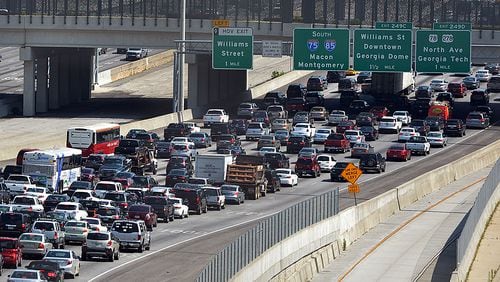Here's something to remember during your holiday travels:
Of all the different parts of metro Atlanta's network of highways and interstates — from Spaghetti Junction to the I-285 south/I-20 west interchange and around — two places make a list of the nation's worst when it comes to bottlenecks, according to one analysis of vehicle speed data and volume.
And specifically for freight — or trucking — bottlenecks, Atlanta is home to the nation's worst of the worst.
The American Highway Users Alliance's 2015 report, "Unclogging America's Arteries," ranks the country's 50 worst highway bottlenecks by the total delay in hours experienced by drivers entering and leaving each one.
Atlanta had two bottlenecks make the list: a 1.3-mile stretch of the Downtown Connector between Freedom Parkway and North Avenue (No. 24) and a 0.3-mile stretch Ga. 400 between Johnson Ferry Road NE and I-285 (No. 49).
The bottlenecked part of the Connector causes 1.2 million total delay hours annually, according to the AHUA report, while the bottlenecked part of Ga. 400 causes 200,000 total delay hours. (And the worst part of that part of the Connector is around Freedom Parkway, not North Avenue, according to AHUA's analysis.)
» Follow Andria Simmons' Route 666 blog for up-to-the-minute Atlanta commuting news «
The AHUA, a non-profit advocacy group, also ranked the 10 worst freight bottlenecks in the country, and I-285 at I-85 north took the top spot.
That's a jump up from No. 3 the year before, "likely" because of the "notorious" jams caused by Snowjam, according to AHUA.
The report goes two steps further in estimating a delay for its ranked bottlenecks, attaching an estimated economic value (calculating lost dollars in terms of the delay hours multiplied by the estimate of a state-specific volunteer wage) and a total number of gallons of fuel used.
So the 1.2 million delay hours caused annually by the Downtown Connector resulted in an estimated $27 million dollars in "lost value" and 392,600 gallons of fuel "wasted," while the delay on 400 resulted in an estimated $6 million dollars and 73,580 gallons of fuel in the same.
It was not immediately clear why the lost value total appeared to use a different wage multiplier for the Connector and 400.
But overall in the study, Atlanta gets off relatively easy, compared to other big cities: Of the 10 worst bottlenecks in the AHUA report, six are in Los Angeles.
A note on the methodology:
The AHUA estimates delay hours by comparing an ideal speed for a given segment of road against the observed speed, using 2014 speed data from the American Transportation Research Institute, a part of the American Trucking Associations (for freight vehicles), and from the mapping and navigation company HERE (for passenger vehicles).
The AHUA also received feedback from state Departments of Transportation, including Georgia's.
The study was conducted for AHUA by CPCS Transcom Inc., a management consulting firm specializing in transportation sector strategy, among other fields.
About the Author






